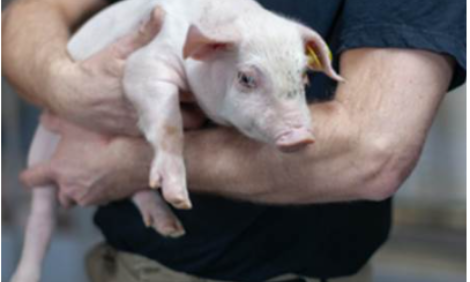



Pork Quality and the Role of Market Organization
By Steve W. Martinez and Kelly Zering for the USDA's Economic Research Service - This study addresses changes in the organization of the U.S. pork industry, most notably marketing contracts between packers and producers, by exploring their function in addressing pork quality concerns.
A number of developments brought quality concerns to the forefront. These include health concerns and corresponding preferences for lean pork, growing incidence of undesirable quality attributes (e.g., pale, soft, and exudative (PSE) meat, a result of breeding for leanness), heightened concerns over food safety and related regulatory programs, and expansion into global markets.
Organizational arrangements can facilitate industry efforts to address pork quality needs by reducing measuring costs, controlling quality attributes that are difficult to measure, facilitating adaptations to changing quality standards, and reducing transaction costs associated with relationship-specific investments in branding programs.
Summary
In the U.S. pork industry, hogs sold through marketing contracts account for
approximately 69 percent of total hog sales, compared with 11 percent in
1993. The rapid growth in marketing contracts corresponds to several developments
that brought pork quality concerns to the forefront. This suggests
possible contract advantages related to changes in quality emphasis.
In the 1990s, several events combined to heighten interest in U.S. pork
quality. In response to health concerns related to fat and cholesterol, packer
adoption of advanced measuring technology and substitution of live hog
grading with carcass pricing grids provided strong incentives for leaner
hogs. At the same time, a pork quality condition, referred to as pale, soft,
exudative (PSE), was associated with the Porcine Stress Syndrome gene
(stress gene), carried by some of the leaner genetic lines. This condition led
to pork with poor processing qualities, less attractive appearance to
consumers, and a tougher/dryer cooked product. As hogs became leaner,
they became more susceptible to producing PSE pork.
Meat safety also gained increasing attention in response to several major
meat recalls due to pathogen content. In 1996, mandated use of a new regulatory
program for meat and poultry, referred to as Hazard Analysis and
Critical Control Point (HACCP), reflected a growing interest in preventing
and controlling food hazards before reaching the consumer.
PSE and safety concerns were further ingrained by U.S. efforts to expand
globally. In the 1990s, the United States experienced unprecedented growth
in pork exports, supported by the passage of free trade agreements. Considerable
headway was made into the Japanese market, the leading U.S. export
customer, where quality concerns are especially important.
Growing interest in improving pork quality likely increased the importance
of measuring and sorting costs associated with hog quality attributes and
price determination. Adoption of carcass pricing programs, which vary by
packer, may have increased producer costs associated with evaluating alternative
packer bids. Carcass grading programs with more narrowly defined
quality groupings also likely raised packer costs of sorting and pricing hogs.
Efforts to reduce these costs provided impetus for packers and producers to
enter into long-term contracts with minimum hog volume delivery requirements.
Long-term agreements with packers allow producers to reduce the
number of times that alternative packer pricing programs must be evaluated.
Also, large numbers of uniform hogs produced under similar production
conditions allow packers to reduce the costs of measuring and sorting hogs
into narrower quality groupings.
Packer costs of measuring PSE pork and food safety attributes are significant,
which provided additional impetus for contract adoption. In particular, a
strong link between hog production inputs, PSE, and safety attributes suggests
that contracts that specify and monitor production activities can reduce these
measuring costs. For example, genetic selection and proper handling procedures
to reduce hog stress can reduce the incidence of PSE pork.
Analysis of a small sample of marketing contracts offered in the Midwest
between 1996 and 2001 provides some additional insight into recent hog
marketing contracts. Most of these contracts rely on formula pricing,
adjusted by a carcass pricing grid, and give the packer some control over
production inputs. Rather than detailed input requirements, however, many
contract provisions express packer expectations for adjusting producer
inputs, or plans for working together to determine input specifications. Such
“relational” terms likely facilitate adaptations to changing pork quality
needs as companies establish branding programs, expand internationally,
and respond to changing food safety standards.
To the extent that packers become dissatisfied with the quality and consistency
of hogs obtained through carcass pricing programs, they may chose to
own or work with genetic companies. Packer branding programs that rely on
a particular type of genetics products may lead to further changes in the
organization of pork markets. Packers may craft more complex marketing
contracts to protect their investments or own and raise their own hogs (i.e.,
vertical integration). In addition to marketing contracts, a host of other organizational
arrangements that blend elements of both spot markets and
vertical integration may be used, including packer-owned hogs that are
raised using production contracts. Such “hybrid” arrangements may offer
advantages in adapting to uncertain market conditions, providing incentives
for efficient resource use, and facilitating coordination through control
devices, such as monitoring.
Links
To read the full report, please click here (PDF)Source: U.S. Department of Agriculture, Economic Research Service - November 2004








